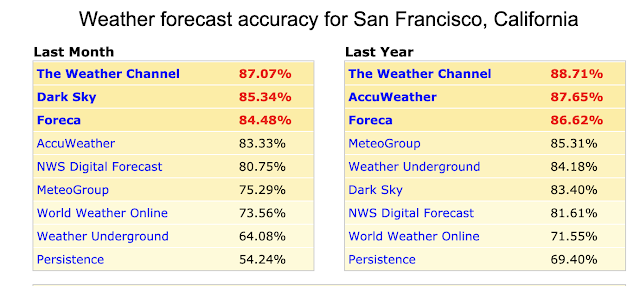Smartphone Weather Apps. Can You Trust Them?
If you picked up the Seattle Times on Wednesday, you would have seen at the very top of the front page a reference to an article "Why your weather apps isn't very good"
______________________________________________________________________
Let me be clear: human forecasters at the National Weather Service are still very valuable. They can spot the rare situations when the automated systems are failing and intervene, they can communicate the forecasts and their uncertainties to the public and key users, and they can monitor the local observation assets, among many other tasks.
But these smartphone weather apps and their online cousins are very, very good, and with improving models, increasing numbers of observations, and the growth in use of machine learning/artificial intelligence for combining all the very information sources, they are only going to get better.
______________________________________________________________________
__________________________________________________________________________
Heading to the article, you learn you can't necessarily trust your smartphone weather app, that one should go "straight to the source" and use the National Weather Service forecast, and that weather apps “ don’t factor in that we are sandwiched in between mountains and the very warm Lake Washington and the warm Pacific.”
________________________________________________________________________
__________________________________________________________________________
Unfortunately, most of the information in the Seattle Times article was simply not true.
The truth is that many of the leading weather apps available on your smartphone (or through your web browser) are VERY GOOD, in fact usually much better than the National Weather Service forecast.
The Real Situation
Fortunately for all of us, there is website that provides verification of weather apps as well as the National Weather Service: https://www.forecastadvisor.com/
Let's take a look at their evaluation of forecast accuracy (1-3 day forecasts, temperature and precipitation) for Seattle, Washington (see below).
The Weather Channel (weather.com, weather channel smartphone app) is the leader, both last month and last year, with others like AccuWeather, WeatherUnderground and Foreca, right behind).
The National Weather Service (NWS Digital Forecast) is lagging the leaders. These results are not a fluke: I look at this website every week and the results during the past few years were very similar. I have verified some of the result myself quantitatively and they were consistent with the above.
Other cities? Pretty much the same story. Here is San Francisco.
The Seattle Times article has a quote that these apps don't know about local terrain effects. This is incorrect. Weather apps like the Weather Channel use local observations and the output from high resolution models.
I know many of you have the same question: why are these weather apps so good and why are they often better than the local meteorologists of the National Weather Service?
This can be easily explained. All the best weather apps follow a similar approach, but let me talk about one I know well, the technology behind the Weather Channel app, which is actually owned and developed by IBM (through one of its companies, WSI).
This underlying forecasting system brings in a wide range of observations and a big collection of forecast models. Such forecast models are not limited to the American models (e.g., GFS) and includes highly skillful international ones (like the European Center). In addition, IBM runs a high resolution model (WRF) over important areas (like the U.S.) and now runs its own global model (MPAS), with extraordinary resolution over the U.S. and Europe.
But the Weather Channel system doesn't stop there. It uses a sophisticated statistical system to combine all these inputs, with weights dependent on past performance. Such technology was based on a system first developed at the National Center for Atmospheric Research (DiCast) and is known as GRAF (Global High-Resolution Atmospheric Forecasting System), with a description here: https://newsroom.ibm.com/graf-democratizing-the-worlds-weather-data)
For most forecast situations, it is very, very difficult for human beings at the National Weather Service (NWS) to beat such a system--that is why NWS skill is generally less than that of the leading apps. IBM is also heavily using technology, models, and science developed by the university community (e.g., NCAR and the universities).
Let me be clear: human forecasters at the National Weather Service are still very valuable. They can spot the rare situations when the automated systems are failing and intervene, they can communicate the forecasts and their uncertainties to the public and key users, and they can monitor the local observation assets, among many other tasks.
But these smartphone weather apps and their online cousins are very, very good, and with improving models, increasing numbers of observations, and the growth in use of machine learning/artificial intelligence for combining all the very information sources, they are only going to get better.









Comments
Post a Comment